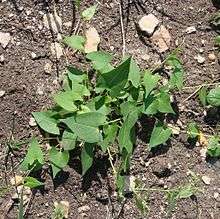Fallopia convolvulus
Fallopia convolvulus, the black-bindweed or wild buckwheat, is a fast-growing annual flowering plant in the family Polygonaceae native throughout Europe, Asia and northern Africa.[2][3][4][5][6]
| Fallopia convolvulus | |
|---|---|
 | |
| Scientific classification | |
| Kingdom: | Plantae |
| Clade: | Tracheophytes |
| Clade: | Angiosperms |
| Clade: | Eudicots |
| Order: | Caryophyllales |
| Family: | Polygonaceae |
| Genus: | Fallopia |
| Species: | F. convolvulus |
| Binomial name | |
| Fallopia convolvulus | |
| Synonyms[1] | |
|
Synonymy
| |
Synonyms include Polygonum convolvulus L. (basionym), Bilderdykia convolvulus (L.) Dumort, Fagopyrum convolvulus (L.) H.Gross, Fagopyrum carinatum Moench, Helxine convolvulus (L.) Raf., Reynoutria convolvulus (L.) Shinners, and Tiniaria convolvulus (L.) Webb & Moq.[3][4] Other old folk names include bear-bind, bind-corn, climbing bindweed, climbing buckwheat, corn-bind, corn bindweed, devil's tether, and wild buckwheat.
Description
Black-bindweed is a herbaceous vine growing to 1–1.5 m (39–59 in) long, with stems that twine clockwise round other plant stems. The alternate triangular leaves are 1.5–6 cm long and 0.7–3 cm broad with a 6–15 (–50) mm petiole; the basal lobes of the leaves are pointed at the petiole. The flowers are small, and greenish-pink to greenish white, clustered on short racemes. These clusters give way to small triangular achenes, with one seed in each achene.[2][3][4][7] The flowers have 5 sepals, the 3 outer ones are larger and show a keel. It has 5 stamens and the fruit grows to 4 mm long.[8]
While it superficially resemble bindweeds in the genus Convolvulus there are many notable differences; it has ocrea (stipule-sheath at nodes), which Convolvulus does not; and Convolvulus has conspicuous trumpet-shaped flowers while Black-bindweed has flowers that are unobtrusive and only about 4 mm long.[5]
Ecology
Fallopia convolvulus grows most commonly on disturbed or cultivated land, in northern Europe typically on warm, sunny, well-drained sandy or limestone soil types,[5][7] but in hotter, drier areas like Pakistan, on moist shady sites.[4] It ranges from sea level in the north of its range, up to 3600 m altitude in the south in the Himalaya.[3][4][5]
Cultivation and uses
The seeds are edible, and were used in the past as a food crop, with remains found in Bronze Age middens.[5] The seeds are too small and low-yielding to make a commercial crop, and it is now more widely considered a weed, occurring in crops, waste areas and roadsides. It can be a damaging weed when it is growing in a garden or crop, as it can not only damage the plant it entwines itself around, but can also hinder mechanised harvesting. It is also an invasive species in North America.[6]
References
- The Plant List, Fallopia convolvulus (L.) Á.Löve
- Flora of NW Europe: Fallopia convolvulus
- Flora of China: Fallopia convolvulus
- Flora of Pakistan: Fallopia convolvulus
- Blamey, M. & Grey-Wilson, C., 1989. Flora of Britain and Northern Europe. ISBN 0-340-40170-2.
- "Fallopia convolvulus". Germplasm Resources Information Network (GRIN). Agricultural Research Service (ARS), United States Department of Agriculture (USDA). Retrieved 24 December 2017.
- Phil Wilson & Miles King, Arable Plants – a field guide: Black-bindweed
- Parnell, J. and Curtis, T. 2012. Webb's An Irish Flora. Cork University Press. ISBN 978-185918-4783